The financial automation market, now worth around 8.1 billion dollars, is expected to more than double to 18.4 billion dollars by 2030, according to Financial Automation - Global Strategic Business Report 2025.
This growth shows how quickly finance teams are turning to automation to get more done in less time. And it's understandable why. Automation helps teams handle more applications, review borrower data, and make credit decisions without getting buried in manual work.
In this article, we'll look at what automated loan processing is and how you can get started yourself.
What is Automated Loan Processing?
Automated loan processing is the use of technology to manage the entire loan origination process, from collecting borrower data to making approval decisions, without relying on repetitive manual work.
Instead of jumping between systems or entering details by hand, funders use connected digital platforms that handle applications, verification, and document management in one place.
Through loan origination automation, data is checked instantly for accuracy, and borrower information is verified against trusted sources. This reduces errors, speeds up reviews, and keeps every step consistent.
For lending teams, automation means faster approvals, lower operational costs, and more time for customer relationships. It also gives better visibility into active loans, payments, and risk trends, which helps funders make smarter, data-driven decisions.
Key Features of Automated Loan Processing
Automated loan processing combines advanced technology and smart software to make the loan lending process faster and more accurate.
Using tools like artificial intelligence, machine learning, and robotic process automation, funders can collect customer data, analyze risk, and make quick loan decisions.
These features help improve loan approval rates, support compliance with industry regulations, and reduce manual work.
- Digital application submission – Simplifies the loan application process by allowing borrowers to submit forms and upload documents online
- Automatic data aggregation and verification – Uses automated tools such as intelligent document processing (IDP) to gather and confirm customer data from various sources for accurate loan evaluations
- AI-driven risk assessment – Applies machine learning and artificial intelligence in lending processes to analyze borrower history and credit scoring, helping decrease risk-associated losses
- Digital document handling – Manages loan agreements and other paperwork with e-signatures and secure cloud storage for easy access
- Automated fund disbursement and servicing – Speeds up fund releases and post-loan management while maintaining full compliance with industry regulations
5 Advantages of an Automated Loan Processing System
Traditional loan processing often takes too long, involves piles of paperwork, and increases the chance of mistakes.
Teams used to spend hours reviewing forms, verifying documents, and checking compliance. This slowed down the loan approval process and frustrated borrowers waiting for updates.
Here are the key reasons that make automated loan workflows important for funders.
1. Faster Loan Approvals
Automation shortens the loan approval process from days to minutes. The system quickly reviews customer information, performs document verification, and checks eligibility.
For example, when a borrower uploads documents, the AI-powered document processing software can instantly validate income sustainability and identity details.
This helps financial institutions process more applications and respond faster, which directly increases customer satisfaction.
2. Improved Data Accuracy
Loan processing automation removes many manual steps that often lead to data entry mistakes. Automated tools verify customer information and flag inconsistencies early.
AI systems also perform fraud detection by checking unusual data patterns, reducing the risk of approving high-risk borrowers. This leads to cleaner, more accurate data across the entire process.
3. Automated Decision-Making
An automated system uses real-time credit scores, payment history, and income data to make quick loan decisions.
Machine learning models can assess risk based on previous borrower behavior, helping loan specialists approve or reject applications confidently.
4. Better Compliance And Transparency
Keeping up with financial regulations can be a challenge for funders. Automated loan processing helps maintain a detailed auditing trail for every step of the loan cycle.
It also checks compliance automatically before final approvals. This improves data security, supports industry regulations, and gives both borrowers and institutions confidence in the process.
5. Lower Costs
Automation helps financial institutions cut labor costs by handling repetitive tasks like document verification and data entry.
With fewer manual steps, you can lower operational costs and become less dependent on large teams or offshore business processing outsourcing (BPO) companies.
At the same time, staff can focus on higher-value work, such as customer support and complex lending cases.
How to Automate Your Loan Process with Heron
Heron is an intelligent automation platform that helps funders and brokers handle high loan volumes with ease.
The platform automates every step of the loan application workflow so you can save time, reduce human errors, and make better lending decisions.
The process starts when brokers or merchants send applications that include ISO forms, bank statements, and other supporting files.
These documents often arrive in different formats, such as emails, PDFs, or scans, and need to be processed before entering your system.
Here's how our end-to-end loan automation would look:
Step 1: Intake
Heron collects incoming applications from brokers or merchants and organizes them automatically.
The system reads each message, identifies attachments, and checks your CRM to see if the sender or business already exists.
Normally, this step involves hours of manual data entry, but Heron does it instantly. The platform gathers all necessary borrower information and prepares it for review, saving your team valuable time.
Step 2: Checks (Scrub)
Heron then validates the collected data using predefined criteria to confirm accuracy and completeness. It checks details such as business state, industry type, bank activity, and transaction patterns.
The system can also identify issues like negative balances or bounced transactions. These checks keep the data clean and consistent before it moves forward, helping your team review borrower creditworthiness and loan eligibility with greater accuracy.
Step 3: Write
After validation, Heron enters the structured data into your system of record automatically. It creates new records such as contacts, entities, and applications.
Information like credit history, requested loan amount, and business background is all organized and stored securely.
This automation removes the need for manual data entry and lowers the risk of human errors.
Step 4: Next Action
Once the data is in your CRM, your team can easily move to the next step. They can reach out to the borrower to confirm details, request missing documents, or mark the file as ready for the underwriting process.
With Heron managing the flow, applications reach your underwriters faster, helping them focus on risk assessment and credit approval.
From 30 Minutes to 20 Seconds: Lexington Capital’s Automation Success
Lexington Capital, a high-volume brokerage in Long Island, faced slow and manual workflows that held back growth.
Their team spent up to 30 minutes reviewing each file, checking bank statements, calculating balances, and searching for errors or fake documents.
These manual steps caused delays, human errors, and lost opportunities when competitors submitted files faster.
Heron solved this by automating the underwriting process from start to finish. The platform extracted key financial data such as revenue, balances, overdrafts, and funder pulls directly from multi-account statements.
It verified accuracy, flagged fraud risks, and delivered structured, ready-to-review data straight into Lexington’s system.
The impact was huge. Processing time dropped by 98% per file, going from 30 minutes to less than 20 seconds. The team tripled its daily volume, handling 3x more deals without adding new staff.
Errors dropped significantly, fraud detection improved, and every submission became cleaner and more fundable.
Heron gave Lexington the speed, accuracy, and confidence they needed to grow. With faster reviews, stronger data validation, and smoother communication with funders, the company gained a clear competitive edge and delivered a better experience for every borrower.

Get Your Team's Precious Time Back with Heron

Free your team from manual processes that burn them out with Heron. With our platform, you and your team no longer need to copy and paste funder decisions or check emails one by one.
The platform connects directly to your existing systems, automates repetitive work, and gives you more time to focus on funding deals and growing your loan portfolio.
Heron helps you move faster, reduce mistakes, and make credit issuance smoother. With real-time automation, your lending operations stay efficient, accurate, and ready to scale.
- Faster turnaround – Heron reduces decision processing time from hours to seconds, giving your team instant access to funder updates
- Automated data flow – Approval and decline details move straight to your CRM without any manual data entry
- Seamless system integration – Works smoothly with your existing systems, so there is no need for a rebuild
- Better team productivity – Frees your team from repetitive data work so they can focus on clients and underwriting
FAQs About Automated Loan Processing
What is automated loan processing?
Automated loan processing uses software to handle most steps in approving and managing loans. It helps loan officers save time, reduces manual errors, and increases operational efficiency in the lending industry.
This system also helps deliver a superior customer experience by speeding up approvals and keeping borrowers informed.
What credit score is needed for a $5000 loan?
The credit score needed for a $5000 loan depends on the funder, but most require a score of at least 600. Some may accept lower scores with higher interest rates.
A stronger score usually improves approval chances and may lead to higher borrower satisfaction due to better loan terms.
What are the 4 stages of the loan process?
The four main stages are application, processing, underwriting, and closing. In these steps, loan officers check credit history, income, and documents to decide if the applicant qualifies.
Tools for the automated loan origination process and payment gateways often help make this process faster and smoother for both borrowers and funders.
Why do I keep getting calls from a loan processing team?
You may be getting calls because your loan application is still being reviewed or is incomplete. The loan processing team might need more details or updates about your information. In some cases, it could also be marketing from funders offering loans or related services.
Get Your Team's Precious Time Back with Heron
.png)